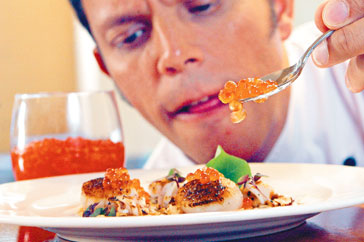Yarra Valley Caviar uses the age-old method to milk salmon, writes Fiona Donnelly.
We arrive at the farm smack bang in the middle of milking. But the sturdy black cattle that cross our path aren’t the centre of attention.
The small group of workers huddled by a pond are focusing their efforts on far more slippery customers – salmon.
Manager Mark Fox and his team are in pursuit of the jewelbright, briny salmon “pearls” that take a starring role at so many of Australia’s top restaurant tables.
“Most commercial hatcheries kill the fish and grow new ones for next year,” Mark explains.
At Yarra Valley Caviar each autumn, during the six-week milking season, they use methods dating back 150 years.
The salmon are caught, placed in holding tanks and then sedated using a food-grade clove oil.
When they fall asleep they are held, hand-milked by firmly stroking their flanks, and then placed in another tank to recover before returning to their pond.
Because female salmon can’t spawn naturally in an aquaculture situation, they need to be milked or their bodies reabsorb the eggs.
“They used to use air to force the eggs out, they stuck a needle into the fish,” Mark says. “It took just 10-15 seconds to blow the eggs out but they were losing half the fish.”
Mark likes to keep things simple, with no antibiotics used on-site, stocks are also kept deliberately low.
“If you give the fish space, lots of oxygen and water then you’ll have healthy fish – to get lots of eggs you just need to give them space,” he says.
Like all Australian-farmed salmon, the Yarra Valley fish are fed canthaxanthin, a dye that mimics the colour of prawns and crustacea, which are eaten in the wild and which give salmon the characteristic pink colour.
Salmon is naturally a light brown colour, explains Mark, and salmon in the wild that feed on pilchards rather than crustaceans are not pink.
“They are now producing organic salmon using prawn waste as part of the feed in Scotland. This is producing very pale fish and they are getting four times the price,” he says.
Mark says at farmers’ markets when he tries to sell salmon that are not brightly coloured customers often refuse to believe it’s salmon.
Chef Alastair McLeod, of Brett’s Wharf and Tank Restaurant, is a firm fan of the ozoney-briny flavoured salmon eggs, pairing them with everything from Jerusalem artichokes and creme fraiche to scallops. “They are a star ingredient for Australia. My brother works in Harrods in London and they’re on sale there,” he says.
“Yarra Valley breeds the fish for the eggs – the flesh is just a value-add. The pearls have a lovely mouthfeel. They’re nice in a vinagrette and with salads – they punctuate dishes, giving little salty explosions in the mouth.
“If you’re going to use them; be generous – otherwise it’s like using just one slice of truffle, there’s no point.”
An indulgent touch, Alastair says the pearls can be used to add a final polish to fish dishes.
“They are fabulous in a risotto just folded in at the last minute, or with a seafood pasta they can really steal the show.”
Visit www.yarravalleysalmon.com.au for more information.
Source
Taste.com.au – The Courier-Mail – May 2011 , Page 3
Author
Fiona Donnelly
http://www.taste.com.au/news+features/articles/2763/stunning+roe+of+pearls
